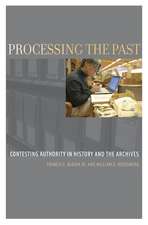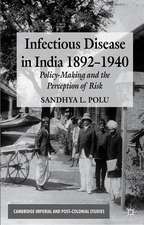Memory, Forgetting and the Moving Image: Palgrave Macmillan Memory Studies
Autor Caterina Albanoen Limba Engleză Hardback – 13 oct 2016
Din seria Palgrave Macmillan Memory Studies
-
 Preț: 358.89 lei
Preț: 358.89 lei -
 Preț: 191.48 lei
Preț: 191.48 lei - 18%
 Preț: 726.37 lei
Preț: 726.37 lei - 20%
 Preț: 691.81 lei
Preț: 691.81 lei -
 Preț: 357.50 lei
Preț: 357.50 lei - 18%
 Preț: 894.46 lei
Preț: 894.46 lei -
 Preț: 382.36 lei
Preț: 382.36 lei - 15%
 Preț: 644.18 lei
Preț: 644.18 lei -
 Preț: 390.63 lei
Preț: 390.63 lei -
 Preț: 382.57 lei
Preț: 382.57 lei - 15%
 Preț: 701.40 lei
Preț: 701.40 lei -
 Preț: 389.70 lei
Preț: 389.70 lei - 18%
 Preț: 782.42 lei
Preț: 782.42 lei -
 Preț: 387.75 lei
Preț: 387.75 lei -
 Preț: 384.86 lei
Preț: 384.86 lei -
 Preț: 392.37 lei
Preț: 392.37 lei -
 Preț: 387.75 lei
Preț: 387.75 lei - 15%
 Preț: 637.78 lei
Preț: 637.78 lei - 18%
 Preț: 776.22 lei
Preț: 776.22 lei - 15%
 Preț: 583.45 lei
Preț: 583.45 lei - 15%
 Preț: 582.12 lei
Preț: 582.12 lei - 15%
 Preț: 642.51 lei
Preț: 642.51 lei - 15%
 Preț: 641.03 lei
Preț: 641.03 lei - 15%
 Preț: 585.26 lei
Preț: 585.26 lei - 15%
 Preț: 641.03 lei
Preț: 641.03 lei - 15%
 Preț: 580.68 lei
Preț: 580.68 lei -
 Preț: 388.13 lei
Preț: 388.13 lei -
 Preț: 380.84 lei
Preț: 380.84 lei -
 Preț: 388.72 lei
Preț: 388.72 lei -
 Preț: 385.08 lei
Preț: 385.08 lei -
 Preț: 386.81 lei
Preț: 386.81 lei -
 Preț: 386.81 lei
Preț: 386.81 lei - 15%
 Preț: 641.03 lei
Preț: 641.03 lei -
 Preț: 383.71 lei
Preț: 383.71 lei - 18%
 Preț: 726.69 lei
Preț: 726.69 lei - 15%
 Preț: 582.63 lei
Preț: 582.63 lei -
 Preț: 387.75 lei
Preț: 387.75 lei - 15%
 Preț: 699.77 lei
Preț: 699.77 lei - 15%
 Preț: 697.00 lei
Preț: 697.00 lei
Preț: 387.58 lei
Nou
Puncte Express: 581
Preț estimativ în valută:
74.17€ • 77.15$ • 61.23£
74.17€ • 77.15$ • 61.23£
Carte tipărită la comandă
Livrare economică 15-29 aprilie
Preluare comenzi: 021 569.72.76
Specificații
ISBN-13: 9781137365873
ISBN-10: 1137365870
Pagini: 224
Ilustrații: XIX, 209 p. 24 illus., 9 illus. in color.
Dimensiuni: 148 x 210 x 20 mm
Greutate: 0.4 kg
Ediția:1st ed. 2016
Editura: Palgrave Macmillan UK
Colecția Palgrave Macmillan
Seria Palgrave Macmillan Memory Studies
Locul publicării:London, United Kingdom
ISBN-10: 1137365870
Pagini: 224
Ilustrații: XIX, 209 p. 24 illus., 9 illus. in color.
Dimensiuni: 148 x 210 x 20 mm
Greutate: 0.4 kg
Ediția:1st ed. 2016
Editura: Palgrave Macmillan UK
Colecția Palgrave Macmillan
Seria Palgrave Macmillan Memory Studies
Locul publicării:London, United Kingdom
Cuprins
Preface.- 1.Memory, Modernity and the Moving Image.- 2.Mémoir(e) and Mémoir(e)s.- 3.Trauma, Latency and Amnesia.- 4.Sound, Trace and Interference.- 5.Amnesia and the Archive.- Conclusion
Notă biografică
Caterina Albano is Reader in Visual Culture and Science at Central Saint Martins, University of the Arts London, UK. Albano publishes, lectures and curates in the fields of art, cultural history and cultural theory, emotion and affect, memory and consciousness; and theory of curating. She is the author of Fear and Art in the Contemporary World (2012).
Textul de pe ultima copertă
Throughout this book we discover what our idea of memory would be without the moving image. This thought provoking analysis examines how the medium has informed modern and contemporary models of memory. The book examines the ways in which cinematic optic procedures inform an understanding of memory processes. Critical to the reciprocity of mind and screen is forgetting and the problematic that it inscribes into memory and its relation to contested histories. Through a consideration of artworks (film/video and sound installation) by artists whose practice has consistently engaged with issues surrounding memory, amnesia and trauma, the book brings to bear neuro-psychological insight and its implication with the moving image (as both image and sound) to a consideration of the global landscape of memory and the politics of memory that inform them. The artists featured include Kerry Tribe, Shona Illingworth, Bill Fontana, Lutz Becker, Yervant Gianikian and Angela Ricci Lucchi, Harun Faorcki, and Eyal Sivan.
Caterina Albano is Reader in Visual Culture and Science at Central Saint Martins, University of the Arts London, UK. Albano publishes, lectures and curates in the fields of art, cultural history and cultural theory, emotion and affect, memory and consciousness; and theory of curating. She is the author of Fear and Art in the Contemporary World (2012).
Caracteristici
Bridges contemporary art (film/video and sound installation), neuropsychology and culture pointing to the synergies and insight that can be gained from this interdisciplinary approach for an understanding of individual and interpersonal, cultural and transcultural remembering Addresses topical issues concerning latency, amnesia, trauma, and interference as relevant to both individual, cultural and transcultural remembering, drawing attention to the impinging affective relevance of what is silenced or unremembered Examines how the moving image has acted and still acts as cultural referent for memory and forgetting through a discussion of contemporary artworks and the immersive memory-scapes that they create Considers the modern and contemporary conceptualization of memory and the theorization of forgetting and argues the centrality of forgetting for an understanding of memory and brings it to bear to today’s global memory practices














